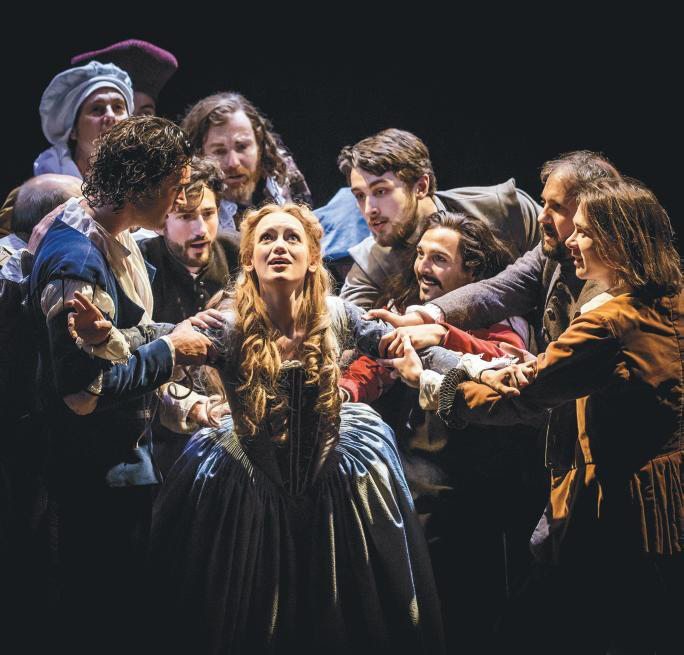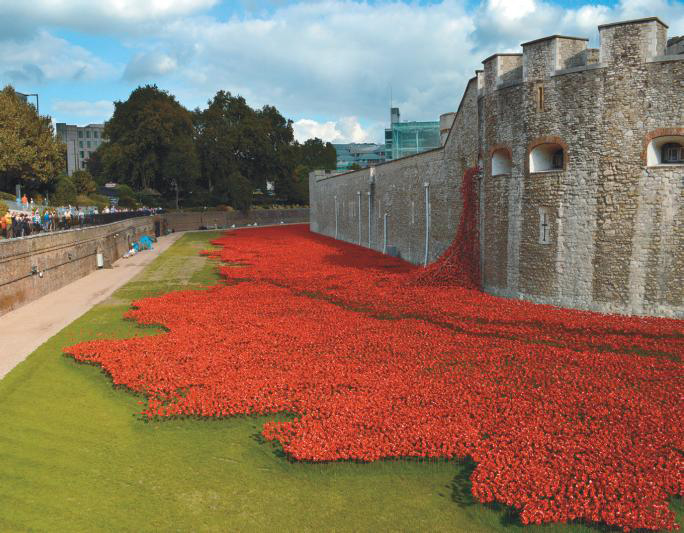
Will Shakespeare's new play "Romeo and Ethel the Pirate's Daughter"
SHAKESPEARE IN LOVE - “COMEDY, LOVE AND A BIT WITH A DOG. That’s what the public wants,” announces struggling 16th-century impresario Philip Henslowe. They don’t want poor old Will Shakespeare’s new play Romeo and Ethel the Pirate’s Daughter. I’ve had my eye on the stage version of Tom Stoppard’s hit movie Shakespeare in Love since I heard it was coming, and rarely have I enjoyed such an exhilarating night at the theatre. Or, indeed, such an entertaining dog.
The show is a big gamble on behalf of its producers. It was a hit movie, but not a guaranteed bums-on-seats theater production. They’ve pushed out every possible boat, including a hilarious water taxi. The 28-strong cast (plus dog) makes this one of the most talked-about productions this year. It is a script that milks laughs from every line, on a set that works as theater, palace, ship and aforesaid water taxi. Costumes drip cash, and acting that is as honest as it is funny. Put simply: it’s wonderful. Did I mention there’s a bit with a dog?
TAKE THE WORLD’S FIRST UNIFORMED POLICE FORCE. British Heritage reader Susan Brooks gave me the tip-off about the River Police Museum. I’d heard of it, but was unaware that people can actually visit (by prior arrangement). The curator, Robert Jeffries, is a former serving offcer himself, and what he doesn’t know about nefarious dockland deeds, secret smugglers, gruesome murders and shifty workers isn’t worth knowing. The museum is housed in the original police building, backing directly onto the river and still used today. It’s just a single room—the old carpenters’ workshop, complete with benches, chests of drawers and the odd vice—and I thought “this will only take half an hour.” I hadn’t counted on Jeffries’ impressive knowledge, impeccable delivery and raconteur style. We descended into an 18th-century world of murky docks and murkier practices.
The force was originally paid for by ship owners tired of being ripped off by their own workers. Each morning skinny East End “lumpers” arrived to unload the ships’ cargoes wearing enormous coats. They left each evening so apparently wellfied their coats hardly met in the middle. Until the end of the docks in the 1960s, it was considered a job perk to fill your pockets with whatever spilled from “accidental breakages,” and the river police were created in 1798 to play an eternal cat-and-mouse game of finding whatever was being landed that day. Jeffries and I spent two hours in that room and still didn’t cover everything. In the end we repaired to the pub for yet more stories.
I HAVE BEEN HINTING LIKE CRAZY for the past X years for someone, anyone to take me to Veeraswamy, the UK’s oldest Indian restaurant, as I sure couldn’t pay for it myself. Created in 1926, the Regent Street restaurant has echoes of imperial India at its most opulent, and luxury at that level never comes cheap. In the end it was a birthday treat and thank heavens, it lived up to its reputation for excellence.
Most UK Indian restaurants have a style you’d never find in India itself. And I confess I’m a sucker for Anglicized tikka-masalas and kormas. Veeraswamy, however, wants nothing to do with that fusion nonsense, instead going for authentic, pan-Indian favors that transported me instantly back to Mumbai, Delhi and Jaipur. With delicately spiced dishes, fluffy white rice and exceptional ingredients, each mouthful was to savor. Instead of going for a single plate of something, I usually order several side dishes to get a variety of favors, creating my own thali. At Veeraswamy they positively encourage that approach. It is an exquisite, sumptuous—and expensive night out.
COMMEMORATION OF THE BEGINNING of World War I is in the very air just now. Every TV channel self-consciously delves for some new quirky aspect, every newspaper vies to unearth some story not yet told, every museum has dug deep into its archives for anything new they can squeeze out. Nothing so far has beaten Blood-Swept Land and Seas of Red, an art installation at the Tower of London that has captured the public imagination beyond the wildest imaginings of Historic Royal Palaces that commissioned the project. What is it? A metaphorical moat of blood-red ceramic poppies gushing from an iron-grilled portcullis in the Tower’s wall, pouring down the ancient stone flanks and fooding the gulley below. Each flower represents a fallen British serviceman in the Great War.
Prepared and fired by hand they are slowly being “planted” ready for Armistice Day on 11th November. At dusk each evening, a bugle sounds the Last Post and the names of 180 more soldiers are read aloud in remembrance as their poppy is added to the slick of sanguine blooms gradually filling the moat. Members of the public can buy one of the 888,246 poppies for charity, which will be shipped to them after the installation finishes.

For More Information
Thames River Police Museum
www.thamespolicemuseum.org.uk/museum
Shakespeare in Love
www.shakespeareinlove.com/
Veeraswamy
www.veeraswamy.com
Blood-Swept Land and Seas of Red
www.hrp.org.uk
Epsom Salt Well
hard to find, but park in spa Drive, walk through an alleyway at the end and cross your fingers—good luck!
OFFICE-SITTING FOR A FRIEND in south west London I found myself alone one evening with a question on my mind: Do Epsom Salts actually come from Epsom? A short web search revealed one Nehemiah Grew was, in 1695, granted a Royal Patent to set up spa in Epsom, selling bitter water from a spring where North Downs chalk collides with London clay, creating magnesium sulphate. I dread to imagine what happened during the recommended long walks after patients drank up to 16 pints of “purging waters,” but the ever-curious Samuel Pepys was undeterred from having a go.
As I set off to search for any lingering remains of the Epsom Salt Well, the heavens opened. In a strange, spooky moment, as I followed an ageing wooden sign on the edge of Epsom Down’s woodlands, the torrent abated, the sun came out and a rainbow appeared in a purple sky as though in some fairy dream. I chased it to what I can only describe as a wishing well surrounded by a circlet of lavender, with a low brick wall and wrought-iron lantern set high above.
Sadly there the magic stops. Instead of nestling among elfin-kissed fields of green, the first Epsom Salt Well is now the centerpiece of a post-war housing estate. It fell into disuse in the 19th century, but was recapped in cute style in 1989. I couldn’t even snap a lovely vision of the rainbow behind my wishing well as a large yellow rubbish skip had lodged itself between the two.
Next time I’ll be back to cheap and cheerful dining, seeking out the gardeners’ church and wondering if it’s ever right to serve champagne in a tankard.

BLOOD-SWEPT LAND AND SEAS OF RED





Comments